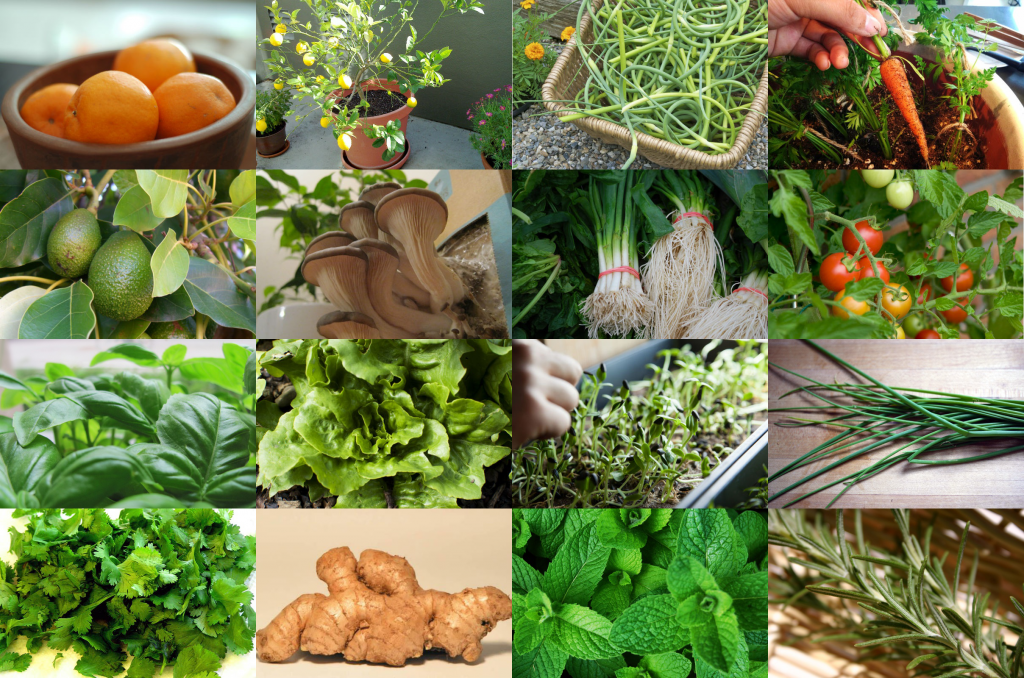 Some of the most delicious herbs, fruits and vegetables can easily be grown indoors providing you give them the adequate light, soil and water they require. Here’s a simple list of 16 Edibles You Can Grow Indoors. To read the entire article along with more detailed instructions, you can visit the original article at: “AGreatist.com“.
Some of the most delicious herbs, fruits and vegetables can easily be grown indoors providing you give them the adequate light, soil and water they require. Here’s a simple list of 16 Edibles You Can Grow Indoors. To read the entire article along with more detailed instructions, you can visit the original article at: “AGreatist.com“.
1. Avocado: It’s possible to grow an avocado tree from an avocado pit, but doing so may not yield edible fruit. If you want to eat what you sow, it’s best to purchase a dwarf avocado plant (varieties that yield the larger green-skinned fruit or the more common black-skinned fruits are equally good) . To tend for your tree, add some sand to the bottom of a large, well-draining pot before filling it with regular potting mix and planting your tree. Water the tree regularly but make sure the soil is never soggy — avocado roots don’t take well to being waterlogged. Prune the shoots regularly, and be sure to place the tree in an area with high ceilings — even dwarf trees can grow higher than 10 feet!
2. Carrots: Purchase carrot seeds and a pot or window box that’s at least a foot and a half deep and wide, with drainage holes at the bottom. Fill the container to within an inch of the top with a humus-rich potting mix. Water the soil before planting the seeds. Plant the seeds one inch apart in rows that are six inches apart from each other, pressing the seeds gently into the soil and covering them with a thin layer of soil. Water. Place the container in an area that receives tons of light. Keep the soil moist, but not soaked. To help preserve moisture, soak some peat moss in water overnight and then spread it on top of the seeds. Expect the seeds to germinate (i.e., start sprouting) in about two weeks.
3. Garlic Greens: Note: Growing actual garlic bulbs indoors is a bit tricky, but you can easily grow garlic greens, which can be used just like scallions. Start by purchasing a few garlic bulbs with small cloves, and don’t be afraid to buy a shattered bulb (i.e., one that’s started to burst or is fully pulled apart). Select a four-inch pot with drainage holes at the bottom (a quart-size yogurt container with holes poked through the bottom will also work) and a small bag of potting soil. Fill the pot with soil to about half an inch below the top of the container. Break the bulbs into individual cloves (leave the peel on), and push each individual clove about an inch into the soil, pointy end up. Plant about 12 cloves close together. Water well and place the container in a sunny spot. Water regularly, making sure that the soil remains moist but not soggy. Green shoots should appear in about a week.
4. Lemons: If you want the option of harvesting fruits right away, purchase a two-to-three-year-old dwarf tree at a nursery. Choose a clay, ceramic, or plastic pot slightly larger than the root ball of your tree, and make sure it has several holes in the bottom. Fill the drainage dish with stones to allow air to circulate. Use a potting soil specifically formulated for citrus trees, or choose a slightly acidic, loam-based potting mix. Place the plant in an area that will receive eight to 12 hours of sunlight each day and will ideally maintain a temperature between 55 and 85 degrees Fahrenheit. Water regularly, but be sure not to over-saturate the soil (it should be moist, not sopping wet). Citrus trees like moist air, so regularly misting the leaves with a spray bottle will help keep the leaves perky.
5. Mandarin Oranges: Purchase dwarf mandarin orange trees for the best chance of growing fruits successfully indoors. The trees will grow best in spacious pots with drainage at the bottom, and in rich soil. They also require a sunny location (rotate the plant regularly to ensure that it receives light evenly on all sides). Water regularly, allowing the soil to dry out slightly between waterings. The trees can grow up to six feet tall, and their root system grows along with them — when the roots begin to grow back on themselves or out of the drainage holes, it’s time to re-pot in a container that’s at least 2 inches larger in diameter.
6. Microgreens: Start by purchasing a variety of seeds, such as radishes, kale, Swiss chard, beets, basil, and dill. Fill a shallow tray (no more than 2 inches deep, often called “seedling trays”) or a shallow pot with a drainage hole and fill the tray to the top with potting mix. Moisten the soil with water, making sure that it’s damp but not wet. Sprinkle the seeds evenly over the soil (they should be close to each other but not touching). Sift a thin layer of soil over the top to cover the seeds. Using a spray bottle, lightly mist the soil. Place the tray on a sunny windowsill in a room that’s between 60 and 70 degrees Fahrenheit. Mist or lightly water the soil daily so it remains moist; don’t let the soil dry out, but also make sure that it isn’t waterlogged. In about three to five days, the seeds will likely germinate — once they do, make sure they get 12-14 hours of light every day. Keep the soil moist at the roots, but avoid soaking the leaves.





















Nothing grows on my balcony.